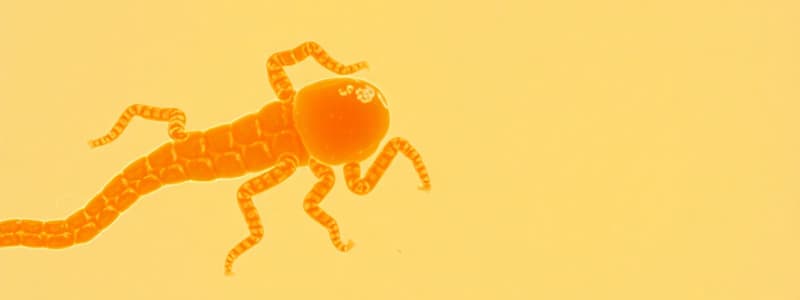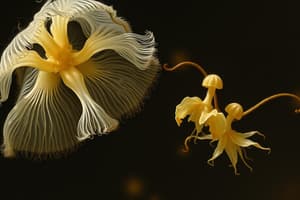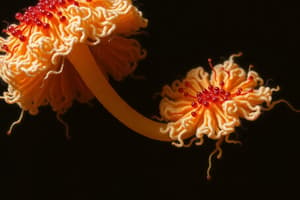Podcast
Questions and Answers
What is the primary mode of transmission for Campylobacter jejuni?
What is the primary mode of transmission for Campylobacter jejuni?
- Direct contact with infected individuals.
- Ingestion of contaminated food, especially poultry, milk, or water. (correct)
- Mosquito bites in tropical regions.
- Airborne droplets produced by coughing or sneezing.
Which characteristic is LEAST associated with Campylobacter jejuni?
Which characteristic is LEAST associated with Campylobacter jejuni?
- Acidophile (correct)
- Motile
- Gram-negative
- Seagull-shaped rod
During a Campylobacter jejuni infection, which part of the gastrointestinal tract is most affected?
During a Campylobacter jejuni infection, which part of the gastrointestinal tract is most affected?
- Duodenum and pancreas
- Appendix and rectum
- Esophagus and stomach
- Jejunum, ileum, and colon (correct)
What role do toxins play in Campylobacter jejuni pathogenesis?
What role do toxins play in Campylobacter jejuni pathogenesis?
What is a distinctive symptom of Campylobacter jejuni infection?
What is a distinctive symptom of Campylobacter jejuni infection?
What factors increase the risk of Campylobacter jejuni infection or the severity of its symptoms?
What factors increase the risk of Campylobacter jejuni infection or the severity of its symptoms?
Which statement accurately describes the diagnosis of Campylobacter jejuni enteritis?
Which statement accurately describes the diagnosis of Campylobacter jejuni enteritis?
Which laboratory practice is crucial when handling faecal specimens for Campylobacter diagnosis?
Which laboratory practice is crucial when handling faecal specimens for Campylobacter diagnosis?
Which treatment options are most appropriate for Campylobacter jejuni infection?
Which treatment options are most appropriate for Campylobacter jejuni infection?
What preventative measures are most effective in controlling the spread of Campylobacter jejuni?
What preventative measures are most effective in controlling the spread of Campylobacter jejuni?
Flashcards
Campylobacter Characteristics
Campylobacter Characteristics
Gram-negative, oxidase-positive, motile rods with complex growth requirements.
Campy Plate
Campy Plate
A selective medium used to isolate Campylobacter from stool specimens.
C. jejuni Transmission
C. jejuni Transmission
Ingestion of contaminated food, especially poultry, milk, or water.
C. jejuni Pathogenesis
C. jejuni Pathogenesis
Signup and view all the flashcards
C. jejuni Symptoms
C. jejuni Symptoms
Signup and view all the flashcards
C. jejuni Treatment
C. jejuni Treatment
Signup and view all the flashcards
Study Notes
- Gram-negative bacteria
- Oxidase-positive
- Motile rods
- Microaerophilic
- Possess complex growth requirements
Campylobacter jejuni
- Features a seagull shape with a single flagellum.
- Campylobacter jejuni is isolated from stool specimens using a selective medium Campy plate
- A leading cause of food poisoning in Europe and the United States.
- Transmitted through ingestion of contaminated food, especially poultry, milk, or water.
Pathogenesis of Campylobacter jejuni
- Following ingestion, C. jejuni invades and damages the mucosal surface of the jejunum, ileum, and colon.
- Endotoxin, enterotoxins, and cytotoxins are produced, however, their precise roles in pathogenesis are not yet fully understood.
- Gastric juices inactivates organisms and are sensitive to complement-mediated killing.
- Organisms invade host cells, penetrating beyond the epithelial cell layer.
- Mesenteric lymph nodes become enlarged, fleshy, and inflamed in developed infections.
- Diarrhea results from intestinal mucosa disruption due to cell invasion and toxin production.
Symptoms of Campylobacter Infection
- Common symptoms include profuse watery bloody diarrhea, malaise, fever, abdominal pain, and cramps.
- Usually self-limiting, but can persist for at least a week.
Epidemiology of Campylobacter jejuni
- Incidence of C. jejuni enteritis peaks in young adults.
- Lack of gastric acid and hypogammaglobulinemia elevate the risk and severity of C. jejuni infection.
Clinical Findings and Diagnosis
- The average incubation period is 3 days, ranging from 1 to 7 days.
- Main symptoms: abdominal pain and diarrhea.
- Nausea is common, but vomiting is less frequent.
- Severe watery diarrhea occurs.
- Leukocytes are almost always present in the feces.
- Symptoms typically resolve within a few days.
- Campylobacter enteritis cannot be clinically distinguished from Salmonella or Shigella infection, however, abdominal pain tends to be more severe.
- In less developed regions, infection often presents as milder diarrhea, while asymptomatic colonization is common.
Laboratory Diagnosis
- Faecal specimens should be refrigerated pending delivery to the laboratory.
- Transport medium should also be used for rectal swabs.
Direct Detection in Feces
- A direct smear or wet preparation of liquid feces can reveal curved rods characteristic of campylobacters.
Microscopy
- Motility and morphology of Campylobacters are sufficiently characteristic.
- While occasionally useful, it is not routinely performed.
Culture
- Isolation of campylobacters from faces requires some form of selective culture to inhibit competing faecal flora.
Treatment
- Rehydration.
- Erythromycin.
- Quinolones.
Prevention and control
- Notes are not provided in the text.
Studying That Suits You
Use AI to generate personalized quizzes and flashcards to suit your learning preferences.




